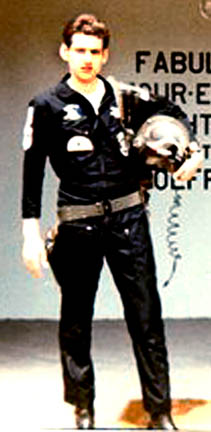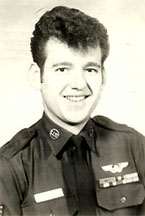|
 James K Caniford James K Caniford
Son of James H Caniford Class 1941
Branch of Service U S Airforce 16th Special Operations Squadron, Ubon Airfield, Thailand
Rank Staff Sergeant
Entered the Service
Discharged
Born 8/26/1948
KIA 3/29/1972
Died: 3/29/1972
Buried
CANIFORD, JAMES KENNETH
Name: James Kenneth Caniford
Rank/Branch: E5/US Air Force
Unit: 16th Special Operations Squadron, Ubon Airfield, Thailand
Date of Birth: 26 August 1948
Home City of Record: Frederick MD
Date of Loss: 29 March 1972
Country of Loss: Laos
Loss Coordinates: 163900N 1060600E (XD165414)
Status (in 1973): Missing In Action Changed to KIA March 2008
Category: 2
Acft/Vehicle/Ground: AC130A
Refno: 1807
Status March 2008
Article April 2008
Other Personnel In Incident: Barclay Young; Howard Stephenson; Henry Brauner;
Curtis D. Miller; Robert Simmons; Edwin Pearce (all missing); Edward Smith;
Richard Halpin; Irving Ramsower; Richard Castillo; Charles Wanzel; Merlyn
Paulson; William Todd; (remains returned)
Source: Compiled by Homecoming II Project 15 March 1991 from one or more of
the following: raw data from U.S. Government agency sources, correspondence
with POW/MIA families, published sources, interviews. Updated by the P.O.W.
NETWORK 1998.
REMARKS: NO PARA - NO RAD CNTCT - SAR NEGA
SYNOPSIS: On the night of March 29, 1972, an AC130A Hercules "Spectre"
gunship departed Ubon Airfield, Thailand on a night reconnaissance mission
over supply routes used by North Vietnamese forces in Laos. The crew of the
aircraft consisted of pilots Maj. Irving B. Ramsower II and 1Lt. Charles J.
Wanzel III, the navigator, Maj. Henry P. Brauner, and crew members Maj.
Howard D. Stephenson, Capt. Curtis D. Miller, Capt. Barclay B. Young, Capt.
Richard Castillo, Capt. Richard C. Halpin, SSgt. Merlyn L. Paulson, SSgt. Edwin J. Pearce, SSgt. Edward D. Smith Jr., SSgt. James K. Caniford; and
Airmen First Class William A. Todd and Robert E. Simmons.
As the aircraft was in the jungle foothills 56 miles east of Savannakhet in
southern Laos, it was shot down by a Russian Surface to Air Missile (SAM).
U.S. government sources stated in February 1986 that a fighter escort plane
reported that the aircraft crashed in a fireball, no parachutes were seen,
nor was radio contact made with the AC130 or any of its crew. In 1972,
however, the Pearce family was told that an F4 support plane traveling with
the AC130 heard "so many beepers they couldn't count them" and that the
emergency beeper type carried by the crew could only be activated manually.
The Pearce family took this as strong proof that a number of the crew
survived. The support aircraft plane left the area to refuel. When it
returned, there were no signs of life.
The inscribed wedding band of Curtis Miller was recovered by a reporter and
returned to Miller's family. The existence of the ring suggests to Miller's
mother that the plane did not burn, and gives her hope that he survived.
A May 1985 article appearing in a Thai newspaper stated that the bodies of
Simmons and Wanzel were among 5 bodies brought to the base camp of Lao
Liberation forces. The same article reported a group of 21 Americans still
alive, held prisoner at a camp in Khammouane Province, Laos. At about this
same time, Simmons' dog tag was mailed anonymously to the U.S. Embassy in
Laos. FBI tests failed to show fire residue on the tag, proving to the
Simmons family that Skeeter did not die in the explosion and go down in the
fiery crash.
The U.S. and Laos excavated this aircraft's crash site in February 1986. The teams recovered a limited number of human bone fragments, personal effects
and large pieces of plane wreckage. It was later announced by the U.S.
Government that the remains of Castillo, Halpin, Ramsower, Simmons, Todd,
Paulson, Pearce, Wanzel and Smith had been positively identified from these
bone fragments.
In a previous excavation at Pakse, Laos in 1985, remains recovered were
positively identified as the 13 crew members, although independent examiners
later proved that only 2 of those identifications were scientifically
possible. The U.S. Government has acknowledged the errors made in identification on two of the men, but these two individuals are still
considered "accounted for".
Because of the identification problems of the first excavation, the families
of the Savannakhet AC130 have carefully considered the information given
them about their loved ones. The families of Robert Simmons and Edwin Pearce
have actively resisted the U.S. Government's identification, which is in
both cases based on a single tooth. These families do not know if their men
are alive or dead, but will insist that the books are kept open until proof
dictates that there is no longer any hope for their survival.
In January 1991, a federal judge ruled that when the Simmons family
collected death benefits for Skeeter, they lost the right to question
whether he was dead. They have continued to fight a positive identification
based on a single tooth. The Assistant U.S. Attorney, William H. Pease,
added that the court has no jurisdiction over military identification of
remains.
Nearly 600 Americans were lost in Laos during the Vietnam war, and many were
known to have survived their loss incident. However, the U.S. did not
negotiate with Laos for these men, and consequently, not one American held
in Laos has ever been released.
Status March 20, 2008
Missing soldier's remains identified
After nearly 40 years, Middletown service member's death in plane crash confirmed
Originally published March 20, 2008After nearly 36 years, James Caniford and his family can stop wondering.
Wednesday morning, the Fort Myers, Fla., resident received a call from the Air Force. An official told him that a recent dig in Laos had unearthed enough material to confirm that his son, U.S. Air Force Staff Sgt. James Kenneth Caniford, was killed in a plane crash during the Vietnam War.
Known as Jimmy, he was the only Vietnam War service member to be classified as a Prisoner of War or Missing in Action from Frederick County. Nationwide, there are roughly 1,800 unaccounted-for service members from the Vietnam War.
The confirmation is unofficial at this point, Caniford said, and the family plans to meet with Air Force officials next week to discuss details about bringing his son's remains back to the United States. It's possible he could be buried with full military honors at Arlington National Cemetery.
Jimmy's younger sister, Shelly Caniford, said hearing the news was terrible, but good -- in part because the family feared Jimmy might have been taken prisoner.
"I thought I'd have to die to see my brother again," she said. "We know he died in the plane crash -- Dad can bring him home and that's a good thing."
The Canifords, originally from Middletown, spent more than 30 years piecing together much of what happened to Jimmy on March 29, 1972.
Early that morning, Jimmy joined 13 other airmen on board an AC-130 gunship on a mission in the heavily defended province of Savannakhet in southern Laos. As an illuminator operator, Jimmy's job was to spot targets on the battlefield.
Before takeoff, Jimmy shared a hot dog and a soda with Ken Felty, a crew member from another plane.
During that mission, three AC-130s flew together, escorted by an F-4E Phantom II. Something went wrong with Felty's plane, which was supposed to fly first in the formation.
Jimmy's crew took the lead instead.
About 3 a.m., the escort spotted three surface-to-air missiles. The first one grazed the gunship, but the second one struck Jimmy's plane, which exploded in flight, sending the pieces tumbling to the ground.
The escort didn't see any parachutes open.
Wreckage burned on the ground, and search and rescue efforts continued for the next two days but no signs of survivors were found. While the wreckage was visible from the air, enemy forces kept ground crews away. |
|
|
|
|
|